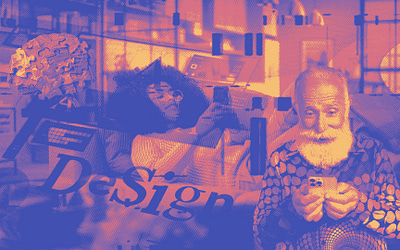Understanding the intricate relationship between human psychology and user interface (UI) and user experience (UX) design is pivotal in crafting digital products that resonate deeply with users. At the heart of effective UI/UX design lies a profound appreciation for the way users think, feel, and behave.
The interplay between human cognition and digital interfaces is a dance of complexity and elegance. Psychology, the scientific study of the mind and behaviour, offers invaluable insights into the human factors that drive interaction with technology. This post delves into the core psychological concepts that underpin human interaction with digital products, from the impact of colours and shapes on user perception to the cognitive processes that guide decision-making and user behaviour.
Our journey through these principles will not only illuminate the reasons behind user preferences and actions but also equip designers with the knowledge to apply these insights in practical design scenarios. Through a deeper understanding of psychology, UI/UX designers can transcend conventional design paradigms, creating products that not only meet users’ functional needs but also connect with them on an emotional and psychological level.
As we navigate through the subsequent sections, we’ll uncover the transformative power of psychology in design, providing a roadmap for creating more human-centric digital experiences that captivate and engage users at every touchpoint.
The Role of Colour Psychology
Colour psychology is a pivotal realm within the UI/UX design domain, wielding the power to evoke specific emotions, influence perceptions, and even drive user actions. This section delves into how colours affect mood and behaviour and offers practical tips for harnessing colour to influence user decisions and enhance the overall aesthetic appeal of digital products.
Understanding Colour and Emotion
Colours are not merely visual attributes; they are experiences that communicate at a subconscious level. Various studies suggest a strong link between colours and psychological responses. For instance, blue is often associated with trust, calm, and reliability, making it a popular choice for banking and social media platforms. Red, on the other hand, evokes urgency and excitement, frequently used in call-to-action buttons or sale announcements to stimulate quick decision-making.
The Functional Role of Colour in UI/UX
Beyond aesthetics, colour plays a crucial role in usability and navigation. Different colours can create visual hierarchies, guide users’ attention to key elements, and improve readability. For example, using contrasting colours for text and background can significantly enhance the legibility of content, while a well-thought-out colour scheme can help users intuitively navigate through a website or app.
Colour and Brand Identity
Colours also contribute to brand recognition and differentiation. Choosing the right colour palette can reinforce a brand’s identity and values, creating a memorable impression on users. It’s essential for UI/UX designers to understand the brand’s essence and select colours that accurately reflect it, ensuring consistency across all digital touchpoints.
Practical Tips for Using Colour in UI/UX Design
- Consider cultural connotations: Colours have different meanings in various cultures. It’s important to research and consider the cultural context of the target audience when selecting colours.
- Test for accessibility: Ensure that colour choices are accessible to all users, including those with colour vision deficiencies. Tools like colour contrast checkers can help validate the accessibility of colour combinations.
- Use colour to denote functionality: Differentiate interactive elements (like buttons and links) using colour to guide users on what actions they can take.
- Create emotion with palettes: Experiment with colour palettes that evoke the desired emotional response from your target audience, aligning with the product’s purpose and user expectations.
- Maintain consistency: Consistency in colour usage across all pages and elements of a product can improve user experience and reinforce brand identity.
By thoughtfully integrating colour psychology into UI/UX design, designers can craft interfaces that not only look aesthetically pleasing but also resonate with users on an emotional level, encouraging engagement and action. This understanding of colour’s psychological impact is fundamental in creating digital experiences that are not just usable, but also deeply connective and memorable.
Principles of Gestalt Psychology
Gestalt psychology, with its roots deeply embedded in the understanding of perceptual organisation, offers invaluable insights for UI/UX designers aiming to create coherent and intuitive digital interfaces. This psychological perspective emphasises how humans perceive elements as whole structures rather than merely the sum of their parts.
The Laws of Perceptual Organisation in Design
Gestalt psychology outlines several principles that describe how people organise visual elements. These principles can be strategically applied to UI/UX design to guide users’ attention and facilitate a seamless interaction with digital products:
- Law of Proximity: Elements that are close to each other are perceived to be more related than elements that are spaced apart. In UI design, grouping related items together, such as navigation links or form fields, can help users process information more efficiently.
- Law of Similarity: Objects that are similar in shape, size, colour, or texture are viewed as part of a group. This principle is useful for categorising information and creating visual consistency across a design.
- Law of Closure: The human mind tends to perceive incomplete shapes as complete. Utilizing this principle, designers can create icons or interface elements that are simple yet recognisable, enhancing the interface’s cleanliness and usability.
- Law of Continuity: Elements arranged in a line or curve are perceived to be more related than those arranged randomly. This principle can guide the design of pathways for the user’s eye to follow, leading them naturally through the layout of a website or app.
- Law of Figure-Ground: This principle describes how people distinguish an object from its background. Using contrasting colours, designers can emphasise important elements, making them stand out and easily identifiable.
Applying Gestalt Principles to Improve Visual Hierarchy and Readability
Incorporating Gestalt principles into UI/UX design can significantly improve the structure and comprehensibility of digital interfaces. For example, by leveraging the law of proximity and similarity, designers can create clear navigation menus that users can intuitively understand and interact with. Similarly, the application of the law of figure-ground can make call-to-action buttons or important notifications stand out, guiding users towards desired actions.
Enhancing User Experience with Gestalt Psychology
The strategic application of Gestalt principles can lead to designs that are not only visually appealing but also highly functional and user-friendly. By understanding how users perceive and organise visual information, designers can create interfaces that naturally align with human cognitive processes. This alignment between design and perception reduces cognitive strain and enhances the overall user experience, making digital products more intuitive and enjoyable to use.
Cognitive Load Theory
Cognitive Load Theory delves into how the human brain processes and stores information, highlighting the importance of designing digital products that align with the cognitive capacities of users. This theory distinguishes between intrinsic, extraneous, and germane cognitive loads, offering a framework for reducing unnecessary mental effort and enhancing learning and interaction within digital environments.
Understanding Working Memory and Information Processing
The human working memory has limited capacity, capable of holding only a finite amount of information at any given time. Cognitive Load Theory suggests that to facilitate effective information processing, UI/UX designers must minimise extraneous load (the effort required to process information irrelevant to the task) and optimise intrinsic load (the effort inherent to the task itself) while promoting germane load (the effort put into creating a permanent store of knowledge).
Strategies to Reduce Cognitive Load for a Smoother User Experience
- Simplify Interface Design: Avoid clutter by removing unnecessary elements that don’t support user tasks, thereby reducing extraneous cognitive load.
- Chunk Information: Break down information into smaller, manageable units or steps, making it easier for users to process and remember, which effectively manages intrinsic load.
- Use Visual Hierarchies: Employ contrast, size, and spacing to emphasise key information, helping users to prioritise and process information more efficiently.
- Integrate Multimedia Learning Principles: Combine text with relevant images or videos to support dual coding theory, which can help decrease cognitive load by utilising both verbal and visual memory channels.
- Provide Clear Instructions and Feedback: Guide users through tasks with clear, concise instructions and immediate feedback, minimising uncertainties and the cognitive effort required to understand the next steps.
The Psychology of Typography
Typography in UI/UX design goes beyond just choosing attractive fonts; it encompasses understanding how typeface choices impact user perception, readability, and the overall user experience. The psychology behind typography informs us that different fonts can evoke different emotions, convey brand identity, and significantly affect usability.
How Typeface Choices Impact Perception and Usability
- Legibility and Readability: The primary function of typography is to communicate text content effectively. Choosing typefaces that are legible and arranging text for optimal readability ensures that users can easily process information.
- Emotional Impact: Fonts have personalities and can generate emotional responses. Serif fonts, for example, are often viewed as traditional and reliable, while sans-serif fonts are perceived as modern and approachable. Selecting a font that aligns with the emotional tone of your content can enhance the user experience.
- Brand Identity: Typography is a critical component of brand identity. Consistent use of a specific set of typefaces across all brand touchpoints can help establish brand recognition and convey the brand’s values and personality.
Guidelines for Selecting Fonts That Enhance Readability and User Engagement
- Contrast: Ensure sufficient contrast between text and its background to facilitate ease of reading.
- Hierarchy: Use different font sizes, weights, and styles to create a visual hierarchy that guides the user’s attention to the most important information first.
- Consistency: Maintain consistent use of typography throughout the user interface to support cognitive fluency and brand cohesion.
- Accessibility: Choose fonts that are accessible to a wide range of users, including those with visual impairments or dyslexia.
Thoughtful typography choices contribute to an intuitive and engaging user experience, encouraging users to spend more time interacting with the content and fostering positive perceptions of the brand.
The Fitts’s Law
Fitts’s Law is a predictive model that quantifies the time required to rapidly move to a target area, such as a button or hyperlink, on a user interface. This principle is fundamental in UI/UX design, as it directly impacts navigation efficiency and user satisfaction.
Applying Fitts’s Law to Optimise Navigation and Placement of Interactive Elements
- Size Matters: Larger targets are easier and faster for users to click on. Ensuring buttons and interactive elements are of adequate size reduces error rates and enhances usability, especially on touchscreens where finger precision is a factor.
- Distance Reduction: Placing frequently used action items, like navigation menus and call-to-action buttons, within easy reach of the user’s natural hand position can significantly decrease the time and effort required to interact with them.
- Edge and Corner Enhancement: Utilising the edges and corners of the screen can be beneficial, as the pointer speed can be maximised due to the infinite edge property, making these areas ideal for placing critical interactive elements.
- Minimise Movement for Common Tasks: Design workflows in such a way that tasks requiring frequent access are made readily available with minimal cursor or touch movement. This can involve thoughtful placement of form fields, navigation links, and other frequently used controls.
Hick’s Law in Decision Making
Hick’s Law offers insight into the cognitive load involved in decision-making processes, stating that the time it takes for a person to make a decision increases with the number and complexity of choices. In the realm of UI/UX design, this law underscores the importance of simplicity and clarity in creating user interfaces that facilitate quick and easy decision-making.
Techniques to Simplify Choices and Streamline User Decisions
- Limit Choices: To prevent choice overload and decision paralysis, limit the number of options presented to users at any given time. This could mean simplifying navigation menus, reducing form fields, or offering fewer product options on e-commerce sites.
- Categorise Options: When numerous options are necessary, organise them into logical categories to help users process the information more efficiently. This method reduces cognitive load by chunking information into more manageable groups.
- Default Settings: Implementing default settings for common selections can streamline decision-making processes for the user, reducing the cognitive load associated with initiating tasks.
- Progressive Disclosure: Use progressive disclosure to present only the information necessary at the moment, hiding more complex or less frequently used options until they are needed. This approach keeps interfaces clean and reduces the overwhelming effect of too many choices.
- Clear Calls to Action: Ensure that calls to action are straightforward and guide the user intuitively towards the next step. Avoid ambiguous language or designs that might confuse users or slow down decision-making.
This not only improves the efficiency of the user’s interaction with the product but also contributes to a more satisfying and engaging overall experience.
Conclusion
The exploration of psychological principles in UI/UX design underscores the profound impact that an understanding of human cognition and behaviour can have on creating digital experiences. From the emotional resonance evoked by colour choices to the navigational efficiency dictated by Fitts’s Law, each principle provides a lens through which designers can refine their craft, ensuring their work is not only visually appealing but deeply connected to the user’s psychological and emotional needs.
The role of psychology in design transcends mere aesthetics, touching upon the very essence of how users interact with and perceive digital products. Cognitive Load Theory and Hick’s Law offer valuable insights into optimising information processing and decision-making, further enhancing usability and user satisfaction.
Typography and emotional design further illustrate the intricate relationship between form and function in UI/UX design, where the choice of typeface or the strategic use of emotional cues can significantly influence user engagement and brand perception. The principles discussed not only serve as tools for improving design outcomes but also embody a broader philosophy of empathy and user-centricity, emphasising the importance of understanding and addressing the user’s psychological needs and expectations.
As we look towards the future of UI/UX design, the integration of psychological principles promises a more sophisticated and human-centred approach to digital product development. The potential for creating more meaningful, effective, and personalised user experiences is vast, with psychology playing a key role in unlocking this potential. Designers equipped with a deep understanding of these principles are better positioned to innovate and lead in the creation of digital environments that not only meet but exceed user expectations, fostering a deeper connection between users and technology.
FAQs
How does psychology improve UI/UX design?
Psychology offers UI/UX designers a deep understanding of how users think, feel, and behave, enabling the creation of more intuitive, engaging, and satisfying digital experiences. By applying psychological principles, designers can predict user reactions, tailor designs to meet emotional and cognitive needs, and ultimately improve usability and user satisfaction. Psychology helps bridge the gap between technology and human experience, ensuring digital products are more user-centric.
Can colour psychology really affect user actions?
Yes, colour psychology can significantly affect user actions. Colours evoke specific emotional responses and can influence perceptions and behaviours. For example, red can create a sense of urgency, often used to attract attention to call-to-action buttons or sales, while blue can convey trust and calm, making it a popular choice for financial and social media platforms. Understanding colour psychology allows designers to strategically use colours to guide user actions and reinforce brand messaging.
What is the most important Gestalt principle for UI/UX design?
While all Gestalt principles are important, the Law of Proximity is particularly crucial for UI/UX design. It states that elements placed close to each other are perceived as related, guiding designers in organising information and interface elements in a way that reflects natural user perceptions. Proper application of the Law of Proximity can greatly enhance the usability and visual clarity of a design, making it easier for users to navigate and understand the content.
How can we measure the emotional impact of a design?
Measuring the emotional impact of a design can be achieved through a combination of user feedback, A/B testing, and analytics. Surveys and interviews can provide direct insights into users’ emotional responses, while A/B testing different design variations can reveal preferences and behaviours. Analytics, such as engagement metrics and conversion rates, can also indicate emotional resonance by showing how users interact with different design elements. Together, these methods offer a comprehensive view of a design’s emotional effectiveness.
How does social proof influence user trust and behaviour?
Social proof, such as testimonials, reviews, and endorsements, significantly influences user trust and behaviour by leveraging the human tendency to follow the actions and opinions of others. When users see that others have had positive experiences with a product or service, they are more likely to trust the brand and make similar decisions. Social proof can enhance credibility, encourage conversions, and build a sense of community around a brand, making it a powerful tool in UI/UX design to guide user actions and perceptions.









